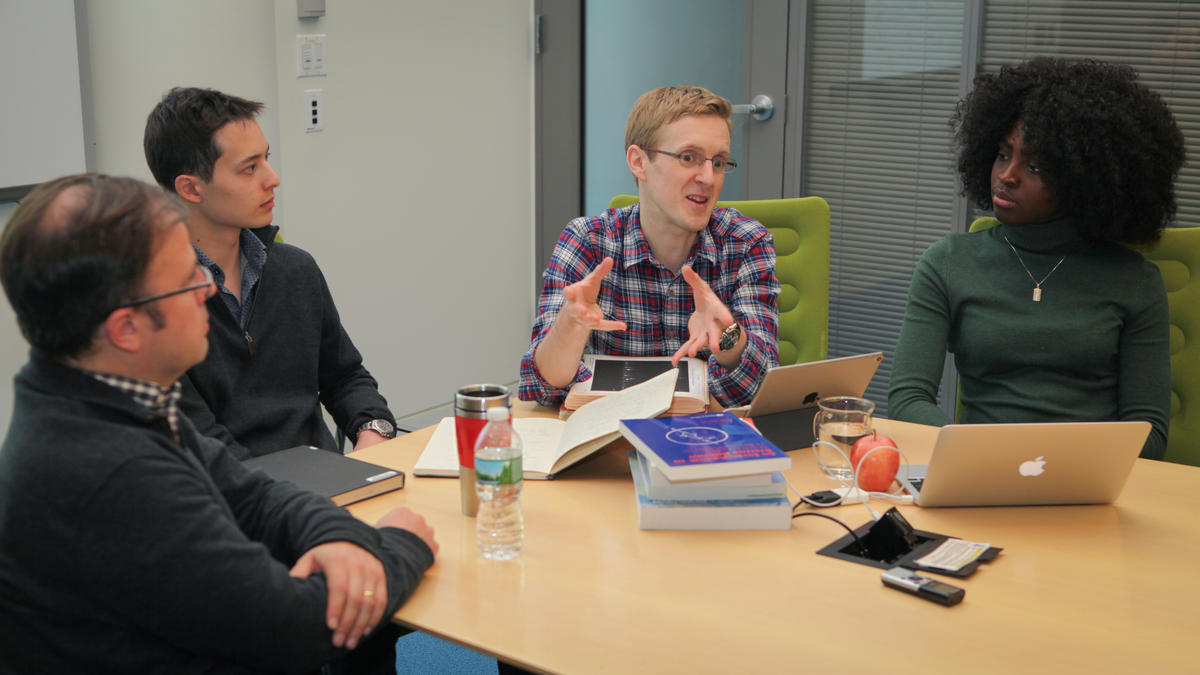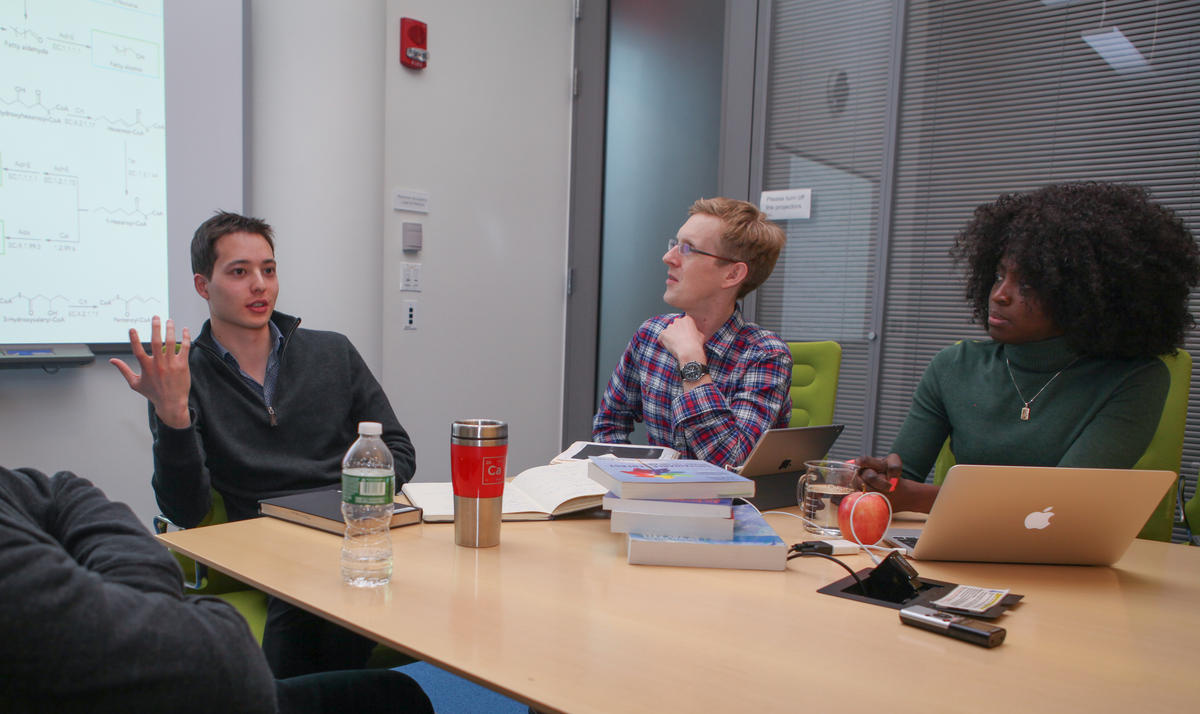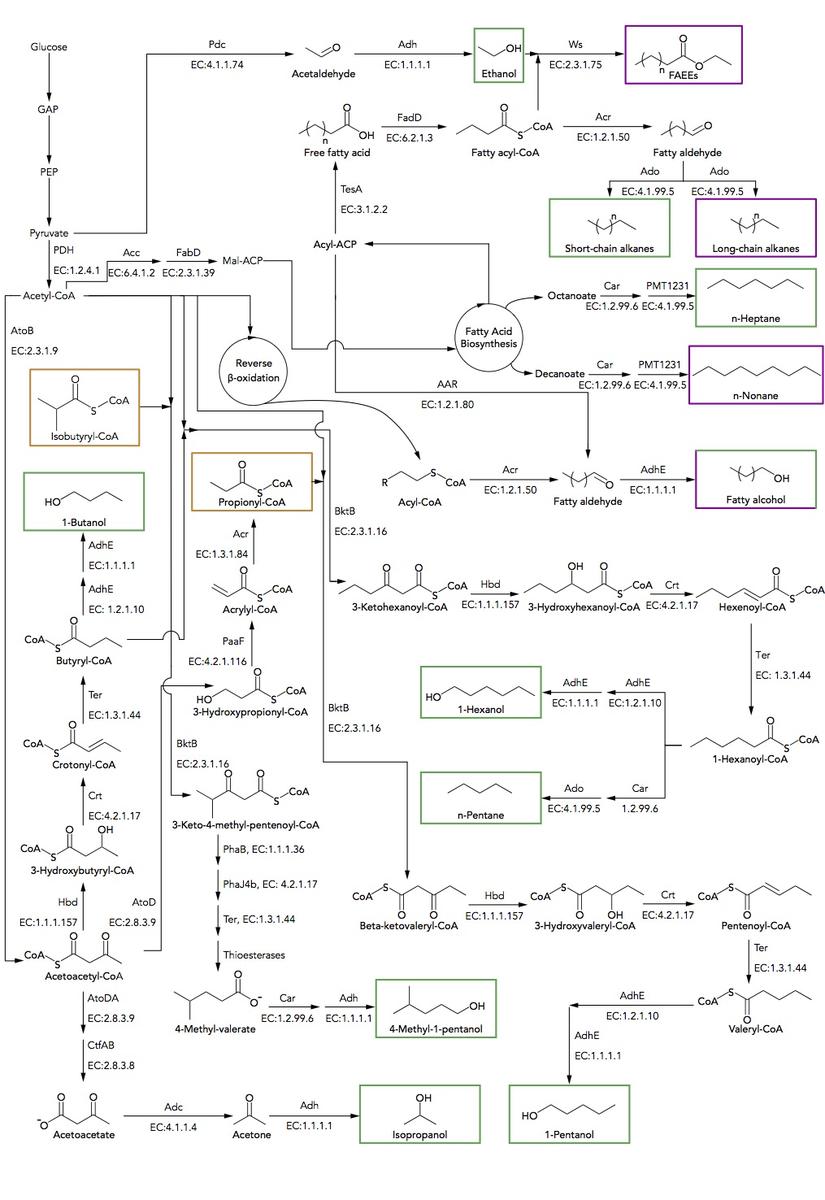[Q&A] Princeton researchers propose biological solutions to sustainable energy problems
Societies are increasingly pressed by growing global energy consumption to respond to the issue of sustainable energy, a challenge that could be uniquely addressed by biological solutions, according to an interdisciplinary team of researchers at Princeton University.
Published in journal Chem, the review article outlines seven challenges in sustainable energy that affect global health and can be addressed through biology-based innovation. In the following Q&A, the co-authors discuss their work as well as the motivations and inspirations behind their collaboration. They are Buz Barstow, a Burroughs-Wellcome Fund Fellow in the chemistry department, and José Avalos, an assistant professor of chemical and biological engineering, Isao Anzai ‘17, Princeton undergraduate researcher, and Oluwakemi Adesina, research specialist. This conversation has been edited for length and clarity.

All photos by C. Todd Reichart
How has biology been used to address energy problems in the past?
Avalos: Biology has been used in medicine for hundreds of years. On the other hand, biology, in the modern sense of the word, has only been used for energy for about 100 years, in WWI, and has picked up steam only in the last 4 or 5 decades. Of course, if you think about humans have been obtaining energy from biological systems for a very long time. For example, one could argue that wood for fire was the first biofuel, or that animals are the oldest workforce. But what I mean is that biology, as a modern scientific discipline has only been applied to energy relatively recently.
Anzai: When I was planning for my senior thesis I was originally intending to make a knockout collection for a pathogen or something medically related. Then Buz and I went on a walk together to discuss an idea for my thesis and what he really convinced me of is that the global energy crisis is really intimately related to global health. So what I’ve been doing is really researching how problems in the energy crisis are directly tied to health problems, and it’s been an exciting way to eventually end up at my original goal.
So what are some energy-crisis related health problems?
Anzai: So as global temperatures rise, it can spur the growth of malaria, for example, and other diseases like cholera. Also the rise of sea levels can cause tremendous damage to coastal cities and areas. Just a whole host of things – also food shortages.

Barstow: My postdoctoral adviser had a phrase that I like: ‘We’re working in a medical school, what could that possibly have to do with sustainable energy? Well, how can we conceivably have healthy people without a healthy planet?’ I think investments in sustainable energy are the cheapest way to improve outcomes in public health globally speaking. Incremental advances in therapeutics, say for cancer, can cost enormous amounts of money, but we could spend that same amount of money on sustainable energy and potentially have a transformative effect on public health
Avalos: I’ve made essentially the same argument [in a proposal to the NIH]. But the reality is that there’s still a lot of disconnect between the health of the planet and the health of the population. That was one of the motivations for us to lay out a peer reviewed article making the claim that biology fundamentally should not be missed because we need to throw everything we have to solve this [energy] problem and biology is going to be key.
How did you think about presenting the case for using biology for energy problems?
Barstow: We came up with it together. We thought about the unique properties of biology. If you think about every feature of biology really depends on biocatalysis and self-assembly.
Barstow: On the right, we made this list of all the areas we thought biology could have an impact on sustainable energy. It’s not exhaustive. These were the important ones and ones we thought we could address. And then we added these color coded links to the capabilities that they depend on. We wanted to convey this idea that biology gives you this toolkit of premade stuff which is really amazing. Abiotic solutions don’t really have this. Biology has had 4.5 billion years to come up with this, and we can mine it today, thanks to systems biology, gene synthesis, bioinformatics and directed evolution.

Avalos: One thing I would add to this figure – the [surrounding] white box would be evolution. That’s something you don’t have in any other discipline addressing the energy challenge. You cannot put a solar cell under certain conditions so that it improves itself with time. In biology you can use evolution to improve on the characteristics of organisms used in these technologies, to get for example faster growth, better chemical production, more efficiency in carbon fixation; if one is clever enough to set up conditions that would select for those traits. Evolution, the fundamental law in biology – that’s something that no other discipline has. That’s unique to biology.
Barstow: The cool thing is you could take that solution that you evolved and thanks to self-assembly you could deploy that on a global scale. I think it’s truly amazing.
Let’s talk about the specific sustainable energy applications for biology.
On safer use of nuclear power:
Barstow: The really key issue was storage of spent nuclear fuel and waste. The problem there is possible contamination of the water. What we know is that with microbes like Shewanella, that we built a [whole genome knockout] collection for, we can electrochemically reduce most of the radionuclides that are in spent nuclear waste so they become insoluble and can’t get in the ground water. Well, we’ve already got this basic proof that it can do something. Can we use genetic engineering to really amp that up?
On mining and separation of rare earth elements, mining and separation of rare earth elements, sustainable manufacture of batteries, and sustainable manufacture of lightweight materials:
Barstow: Dan Steingart [Princeton assistant professor of mechanical and aerospace engineering] really turned me on to this idea through his work on batteries. Rare earth metals are essential for high efficiency electronics and hi-efficiency lighting, alloys that let you make lighter aircraft, cars.
Even though they’re called rare, rare earths are fairly evenly distributed around the world. But purifying them more often takes some fairly horrible high-temperature chemistry. Biology can be used, so far in small scale, to leach them out of the ground and to purify them at room temperature.
Electric cars are great in terms of energy cost per mile until you factor in the cost of manufacturing the battery and the carbon emissions of making the battery. Mineralizing microbes that can be used to make nanostructured electrodes for batteries that last longer, are more powerful, and have better energy density.
On converting biomass to biofuels:

Anzai: Kemi and I worked on drawing these metabolic pathways. For example, I worked on the first beta oxidation pathway. We’re seeing natural pathways that are occurring in the organisms and identifying locations where we can branch off and direct the synthesis of unnatural products. This is a key application of biology because if we can engineer or enhance/depress an enzyme we can shunt the pathway to something we want to produce.
Avalos: All of these arrows are connected by enzymes each of which has unique chemistries, unique ways to balance the different energy currencies in the cell. Fundamentally what you’re trying to do is capture metabolic products that have high density of electrons, heavily reduced molecules, that’s how you get energy.
Anzai: When I was making these figures, I recognized some of the compounds that I learned in my biochemistry class, but these were just a small fraction of all the compounds and pathways put together, and it was exciting to be able to see them all in one figure.
It was also an incredible learning experience to make the figures, not just the material in them but the software used to make them. These are tools that will definitely be useful for the rest of my career.
Adesina: When we were researching the enzymes for each step, if you were to take an enzyme and substrate, how drastic the direction it can go. A lot of simple organic chemistry comes into play, but it also took a lot of work to understand the mechanics of each reaction. Learning and understanding what each enzyme is doing on a chemical level, it’s pretty amazing.

Avalos: I think this is one of the most complete and updated maps out there, of what researchers from around the world have done to produce biofuels. It gives you an appreciation of how you can go in different directions to obtain different product and not every direction is equally efficient for many reasons, because of the catalyst or the requirements of energy. This is only one dimension of the universe of metabolism and not all arrows are equal.
On enhancing the efficiency of photosynthesis, storing renewable electricity as biofuels and genetic Engineering
Barstow: For a lot of the past decade, there’s been this concern around biofuels that I share. If you want to expand bioenergy, will that come at the expense of the land for making food or land for wilderness? Jose had this really compelling argument that the situation is not as dire as most people think it is.
Avalos: There’s what’s called the Billion Ton Study done by the US Departments of Energy and Agriculture. Essentially, the conclusion is that the US has the potential to produce over a billion tons (between 1.1 and 1.5) of dry biomass for biofuels every year sustainably by 2030 without disrupting food production or displacing forests. This would be enough biomass to replace more than 30% of the current US petroleum consumption with biofuels sustainably.
Barstow: But having said that we felt that there is going to be an upper limit from how much you can get from natural biology.
Avalos: Well that’s true, 30% is a big piece, but there is still 70% that we don’t know how to replace sustainably. We will have to come up with new ideas to replace the rest. There are many non-biotic technologies that will help us get there of course, but synthetic biology will play a key role in it as well.
Barstow: Then finally, we have this plug about storing renewable electricity and nuclear energy as biofuels. The article ends with a section about all of the tools that we need to make this happen like directed evolution, and figuring out how biology does a lot of the tricks that we want to take advantage of – we don’t really know this yet.
From writing this paper, what were the big takeaways for each of you?
Anzai: Really the whole range of applications is remarkable to see. I definitely learned a lot.
Adesina: I agree, just seeing the range was great. Obviously people have all of these different views of what they think biology can do. Just seeing all the different perspectives, from a health point of view to marine biology to climate change.
Barstow: I felt like coming into this I had a lot of nebulous ideas, but making this list made those ideas much more concrete.
Avalos: Totally agree, nothing makes it clearer than writing it down. That and also one of the valuable things about this paper is that it’s very inclusive of all the ways biology can help solve the challenge of producing sustainable energy. I don’t think as a whole it’s described in another article in this way. I hope that it’ll help bring new attention and better appreciation for the role biology has in the future of energy.
